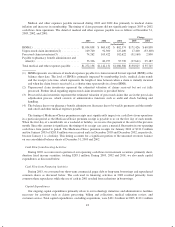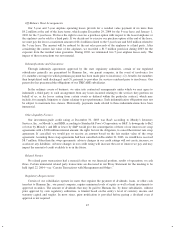Humana 2003 Annual Report Download - page 47
Download and view the complete annual report
Please find page 47 of the 2003 Humana annual report below. You can navigate through the pages in the report by either clicking on the pages listed below, or by using the keyword search tool below to find specific information within the annual report.
Overview
Net income was $142.8 million, or $0.85 per diluted share, in 2002 compared to net income of $117.2
million, or $0.70 per diluted share, in 2001. The increase in earnings primarily resulted from premium revenues
increasing more than operating costs in both our Commercial and Government segments and the non-
amortization of goodwill partially offset by expenses for asset impairments and other unusual items.
Premium Revenues and Medical Membership
Premium revenues increased 10.0%, to $10.9 billion, for 2002 compared to $9.9 billion for 2001. Higher
premium revenues resulted primarily from significant increases in fully insured commercial per member
premiums and an increase in TRICARE premiums. Items impacting per member premiums include changes in
premium and government reimbursement rates, as well as changes in geographic mix of membership, the mix of
product offerings, and the mix of benefit plans selected by our membership.
Commercial segment premium revenues increased 11.2%, to $5.8 billion, for 2002 compared to $5.2 billion
for 2001. This increase primarily resulted from increases in fully insured commercial per member premiums in
the 12% to 14% range for 2002. Additionally, our fully insured commercial medical membership increased 1.7%
or 39,000 members, to 2,340,300 at December 31, 2002 compared to 2,301,300 at December 31, 2001.
Government segment premium revenues increased 8.5%, to $5.1 billion, for 2002 compared to $4.7 billion
for 2001. This increase was primarily attributable to our TRICARE business, partially offset by a reduction in our
Medicare+Choice membership.
TRICARE premium revenues were $2.0 billion, an increase of $660 million or 49.2% compared to 2001.
$334 million of the increase in TRICARE premium revenues is attributable to the acquisition of TRICARE
Regions 2 and 5 on May 31, 2001, with the remainder of the increase attributable to the annual increase in our
contractually determined base revenues and increases in premium revenues recorded as a result of bid price
adjustments, or BPAs, and change orders.
Increasing premium revenues recorded in connection with BPAs resulted from an increase in the number of
eligible TRICARE beneficiaries and a decrease in the use of military treatment facilities, or MTFs, by TRICARE
beneficiaries. The number of TRICARE beneficiaries increased in 2002 as a result of the events of September 11,
2001, the subsequent build-up of military personnel to support military operations in Afghanistan, and the
continuing build-up of military personnel surrounding other international tensions. A decline in the usage of
MTFs occurred for some periods after September 11, 2001 when certain MTFs were restricted by the Department
of Defense resulting in a greater use of our provider network by retired military personnel and the dependents of
both active duty and retired military personnel. Increasing premium revenues recorded in connection with change
orders primarily resulted from expanded benefits for TRICARE beneficiaries as mandated by Congress which
includes, among other items, a reduction of the beneficiary out-of-pocket maximum cost and the elimination of
certain copayments.
Collectively, all of these actions resulted in higher medical expenses during 2002. Since these actions were
not originally specified in our contracts, we were entitled to equitable revenue adjustments via the change order
and BPA process. We recognized revenues related to these adjustments when the settlement amount became
determinable and the collectibility was reasonably assured.
Medicare+Choice premium revenues were $2.6 billion in 2002, a decrease of 9.6% from $2.9 billion in
2001. Medicare+Choice membership was 344,100 at December 31, 2002, compared to 393,900 at December 31,
2001, a decline of 49,800 members, or 12.6%. Medicare+Choice per member premiums increased 5.6% in 2002.
The decrease in membership was due to our exit of various counties on January 1, 2002, as well as attrition in
certain markets as a result of annual changes to benefit designs.
39
























